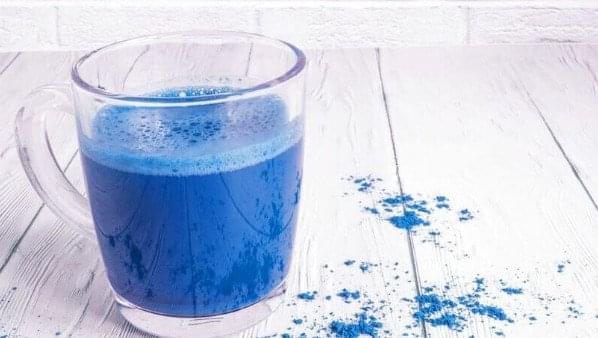Blue Matcha: The Mermaid-Inspired Drink You Should Know About

Meta Description: Looking for a new ingredient to add to your smoothie bowl? Try blue matcha! Although it lacks the same health benefits as green matcha, it will add some color and aesthetics to your drinks.
It’s a Hot Topic

Blue matcha is a trendy topic due to its unique color and health benefits. People are interested in trying new and unique foods and beverages, and blue matcha offers a visually stunning and healthy option.
Additionally, social media platforms like Instagram have made it easier for people to discover and share trendy foods, contributing to blue matcha’s popularity.
Finally, with increasing awareness about the benefits of natural and plant-based foods, blue matcha has gained attention as a healthy and nutritious alternative to traditional matcha.
Learn more about blue matcha and its benefits here.
Are you tired of the same old green matcha? Try something new with blue matcha! This bright and dreamy powder will definitely give off some serious mermaid vibes in your drinks. But what exactly is blue matcha? Does it offer the same health benefits as green matcha?
What is Matcha?
Before we delve into the details of blue matcha, let’s first learn more about traditional matcha. Matcha is a green tea from Camellia sinensis, the same plant as other caffeinated teas.
Unlike regular green tea, where the leaves are steeped in hot water and removed, matcha leaves are ground into a fine green powder and mixed with other substances.
Matcha tea leaves are also cultivated uniquely: the plants are grown in the shade for a period to increase the chlorophyll content of the leaves. This makes them nutrient-rich and a brighter shade of green, according to a 2021 article in Frontiers of Plant Science.
Matcha is popular in Japan and traditionally associated with tea ceremonies. It is also gaining popularity in the US and other parts of the world because of the health-benefiting compounds it contains. These include antioxidants, caffeine, and L-theanine.
What is Blue Matcha?
Now, let’s talk about blue matcha. Despite its name, blue matcha has little in common with the traditional green matcha, according to Cynthia Sass, MPH, RD, a registered dietitian nutritionist and author of several health and nutrition books.
Blue matcha powder comes from a completely different plant: the butterfly pea. The plant, native to Asia, blooms flowers that are dried and ground into powder form.
What Are the Benefits of Blue Matcha?
Blue matcha lacks the same properties that put traditional matcha on the map. It hasn’t been shown to contain caffeine or L-theanine, and there’s not enough evidence to suggest that it has antioxidant compounds.
However, it’s not necessarily a bad thing to add blue matcha to your smoothie bowl. It may even offer some perks: A 2019 study published in Biology found that butterfly pea extract curbed the body’s response to high-fat meals.
Blue matcha may be worth a try if you’re looking for a new ingredient to add to your smoothie bowl. It won’t offer the same health benefits as green matcha, but it will add some color and aesthetics to your drinks. Plus, it’s always fun to try new things!
Is Blue Matcha Accessible?
Blue matcha, also known as butterfly pea flower tea, is a popular tea available in the USA and Europe. It is widely available in specialty tea shops, health food stores, and online retailers.
The cost of blue matcha can vary depending on the retailer, the brand, and the quantity purchased. As of 2023, the average cost for a 1-ounce package of blue matcha is around $10 to $15 USD in the USA and €8 to €12 EUR in Europe.
However, prices may vary depending on location and supplier. It is always best to check with the retailer or online store for the most up-to-date pricing information.
Conclusion
In conclusion, although blue matcha shares the same name as green matcha, the two substances are very different. Green matcha comes from the ground-up tea leaves of the plant Camellia sinensis, while blue matcha is a powder derived from the butterfly pea plant. If you want to try out blue matcha, buy some and start experimenting with your own beautiful beverages and confections.
5 frequently asked questions about blue matcha:
What is blue matcha?
Blue matcha, also known as butterfly pea flower tea, is a caffeine-free herbal tea made from the dried flowers of the butterfly pea plant. The tea is naturally blue, which can change to purple or pink when lemon juice or other acidic ingredients are added.
Does blue matcha taste like green tea matcha?
No, blue matcha has a different taste profile than green tea matcha. Blue matcha has a subtle earthy flavor and a slightly sweet, floral aroma. It is often used as a natural food coloring or a base for cocktails and other beverages.
What are the health benefits of blue matcha?
Blue matcha is rich in antioxidants and has been linked to various health benefits, including improved digestion, reduced inflammation, and lowered blood pressure. However, more research is needed to understand its health benefits fully.
Where can I buy blue matcha?
Blue matcha is available online through various tea retailers and health food stores. It can also be found at some cafes and restaurants specializing in tea beverages.
How much does blue matcha cost?
The cost of blue matcha can vary depending on the brand, quality, and quantity. In general, you can expect to pay around $10 to $20 for a 50-gram bag of loose leaf blue matcha. Ready-to-drink blue matcha beverages can range from $3 to $7 per bottle.